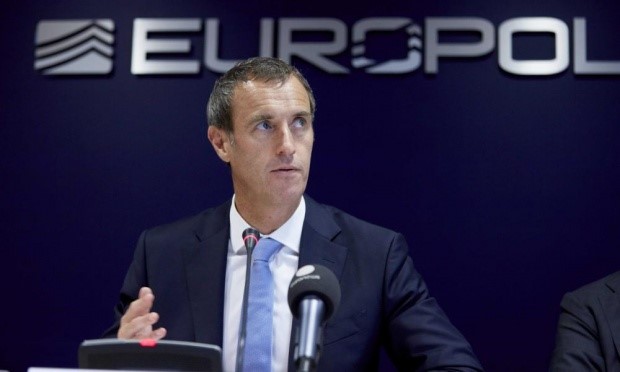Zerohedge: If Russian and Western airstrikes are “degrading and defeating” Islamic State, someone forgot to tell al-Hayat Media Center, the brain trust for a sprawling network of discrete propaganda production units that are spread across nearly a dozen countries.
While the group’s operational capabilities may be dwindling, its propaganda arm is apparently no worse for wear having released dozens of clips this month, including a brand new video out Sunday featuring the Paris attackers.
Over the course of 17 minutes, the group celebrates the November attacks with a montage of clips taken from the Western media’s coverage of the massacre. The video also shows each attacker including alleged ringleader Abdelhamid Abaaoud whose voice is can be heard throughout. “It allegedly features one of the Bataclan theater attackers and a suicide bomber Omar Ismail Mostefai, named in the video as Abu Rayyan Al-Faransi,” RT notes.

Of course there’s the obligatory execution footage including beheadings and firing squads and near the end, French President Francois Hollande’s face is superimposed over the severed head of a prisoner.

The group also threatens British PM David Cameron who appears with a red bullseye on his face.

“We are in the process of examining this latest propaganda video which is another move from an appalling terrorist group that’s clearly in decline and in retreat,” Cameron’s spokeswoman told Reuters on Monday.
“The following are the final messages of the nine lions of the khilafah who were mobilized from their dens to bring an entire country — France — to her knees,” the video reads, after which each attacker records their “final message” to the world prior to the suicide mission.
Hours after the video was released, Europol said ISIS is planning “large scale attacks” in Europe.
“A report coinciding with the opening of a new counterterror centre in the Hague shows how the so-called Islamic State had developed a new combat style capability to carry out a campaign of large-scale terrorist attacks on a global stage — with a particular focus in Europe,” the chief of the EU police agency told reporters today.
What shouldn’t get lost here is that ISIS conducts near daily attacks across the globe, but those tragedies are generally relegated to the back pages because they occur outside of the “civilized” world. If and when the group does strike Europe again, you can bet that will be the last straw for voters exasperated with the flood of asylum seekers flooding across the bloc’s porous borders. In other words, Schengen is one suicide bomb away from being officially dismantled, which means that the next time someone dies in a suicide attack in Europe, Europe itself will die with them.

Further:
Islamic State Plans Attacks From Camps in Europe, Europol Says
Islamic State has set up a special operations command to mastermind more terrorist attacks on “soft targets” in Europe, drawing on training camps on European soil and with France as the most at-risk country, the European Union’s crime-fighting agency said.
The model is the simultaneous shootings at several locations in Paris in November which killed 130, with most of the bloodshed at a concert hall in eastern Paris, said the agency, known as Europol.
It is possible that similar operations “are currently being planned and prepared,” Europol said in a report released on Monday during a meeting of EU interior ministers in Amsterdam. “The wide range of possible targets in combination with an opportunistic approach of locally based groups creates a huge variety of possible scenarios for future terrorist events.”
While Syria remains the hub, Islamic State has set up “smaller scale” training camps in the 28-nation EU and in the Balkans, granting local operatives greater tactical freedom to strike at will, Europol said.
France has no evidence of terrorist indoctrination camps on its soil, Interior Minister Bernard Cazeneuve told reporters. While calling the threat level “high” in Europe and “extremely high” in France, he said the Europol assessment dates to early December and doesn’t go beyond what France has already disclosed.
“The problem isn’t national: it’s European, it’s global,” Cazeneuve said. He backed initiatives to clamp down on arms trafficking, enforce full passport screenings of all travelers to Europe and link up passenger and criminal databases.
The terror effect of massacring unprotected civilians has led Islamic State to favor “soft targets” over infrastructure such as electrical lines, nuclear plants or transport networks, Europol said.
***
The director of Europol Rob Wainwright announced a new European counter-terrorism centre opening this month to fight the terrorism.
SecurityAffairs: The terrorism is perceived as the principal threat for the Western countries, for this reason the European State members announced the creation of a new European counter-terrorism centre.
The centre is opening this month, it aims to improve information-sharing among national law enforcement bodies involved in investigation on terrorism activities. The creation of the centre represents an urgency after the tragic events in Paris.
“It establishes for the first time in Europe a dedicated operation centre,” explained the director of Europol Rob Wainwright in an interview with AFP at the World Economic Forum in Davos (Switzerland).
“It will provide French and Belgian police services and their counterparts around Europe with the platform they need to share information more quickly and to crack down on the terrorist groups that are active.”
The counter-terrorism centre was announced in March 2015, Government ministers from EU member states proposed the unit at an EU Justice and Home Affairs Council meeting. The new Internet Referral Unit would come under the control of Europol, the intent was to launch the new counter-terrorism unit by 1 June 2015.
“The internet is a major facilitator for radicalisation to terrorism. Addressing this matter poses a number of different challenges,” a briefing document detailing the plans says. It adds: “The sheer volume of internet content promoting terrorism and extremism requires pooling of resources and a close cooperation with the industry.” reported the BBC.
Gilles de Kerchove, the EU’s counter-terrorism chief, explained that tragic events of Charlie Hebdo in Paris elevated the need to tackle extremism across the Union, with a specific reference to online activities of cells of terrorists operating on the Internet.
In Europe, various states already have in place operative units that investigated on terrorism on the Internet, one of the most popular team in the British Counter Terrorism Internet Referral Unit (CTIRU).
The new counter-terrorism unit planned by European Governments will rely on a strong co-operation of different intelligence agencies and law enforcement.
It will be expected to flag “terrorist and extremist online content”, the unit will provide the necessary support to the investigations by law enforcement agencies and will improve information sharing on the threat.
“Each member state would be expected to nominate a partner authority to work with the new unit.” “This can be the national cybercrime or internet safety department, or a dedicated unit dealing with terrorist content on-line,” states the document.
Clearly, after the attacks in Paris in November, everything changed, Europe has discovered itself fragile, but compact against a common threat, the ISIS radical group.
“We will be working to improve intelligence sharing and to maximise our capability to track terrorist financing,” Wainwright said.
The new centre is located at the Europol’s headquarters in the Hague, it will try to monitor any activity online conducted by extremist groups, investigating how these groups exploit the Internet for their operations.
[extremist groups]”are abusing the Internet and social media, in particular for their propaganda and recruitment purposes,” Mr. Wainwright added.

Wainwright explained the consequence of the tragic events in Paris, confirming that European law enforcement agencies are intensifying their collaboration to face the threat that is also mastering new technologies.
“In the context of what happened after the attacks in Paris, France and Belgium have established an extremely close working relationship involving Europol,” he said.
“What I have seen over the last few years but particularly in the last year, in the face of the worst terrorist attacks we have seen in Europe for over a decade, is intensified cooperation.”
Wainwright also revealed his concerns about the “significant growth” in the faking of ID documents for use by extremists. According to a report issued by the US intelligence at the end of 2015, the ISIS has the ability to create fake Syrian passports.
Law enforcement believes at least two of the Paris suicide bombers entered Europe through Greece, using fake documents.
“There are many criminal actors that have become more active, more sophisticated and also the quality of the faked documents they are providing (has improved), and they responded to the opportunities that the migration crisis in 2015 gave us,” he said.
“So we need to make sure that our border guard officials are alive to that threat, that they are better trained, of course, and to make sure that there is access to the right databases, including the dedicated database that Interpol has on lost and stolen documents.”

